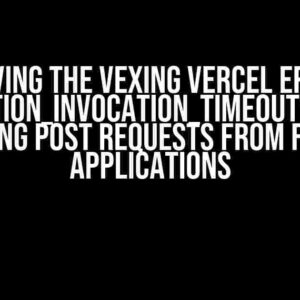Are you tired of dealing with messy URLs and struggling to optimize your website’s performance? Look no further! In this comprehensive guide, we’ll delve into the world of URL rewrite logic for CloudFront Functions, and by the end of it, you’ll be a master of crafting seamless URL transformations that boost your website’s speed and user experience.
What is URL Rewrite Logic, and Why Do You Need It?
URL rewrite logic is a powerful feature in CloudFront Functions that allows you to modify incoming URLs to optimize performance, enhance security, and improve user experience. By rewriting URLs, you can:
- Canonize URLs to avoid duplicate content issues
- Remove unnecessary parameters to reduce latency
- Implement URL normalization to simplify route handling
- Enhance security by removing sensitive information from URLs
- Improve SEO by creating clean, descriptive URLs
In this article, we’ll focus on the implementation of URL rewrite logic for CloudFront Functions, providing you with practical examples and hands-on instructions to get started.
Preparation is Key: Understanding CloudFront Functions and URL Rewrite Logic
Before diving into the implementation, it’s essential to understand the basics of CloudFront Functions and URL rewrite logic.
CloudFront Functions: A Quick Overview
CloudFront Functions is a serverless edge computing service provided by AWS, which allows you to run custom code at the edge of your application, closer to your users. This enables you to optimize performance, security, and user experience by executing logic at the edge.
URL Rewrite Logic: How It Works
URL rewrite logic is a feature within CloudFront Functions that allows you to modify incoming URLs using a set of rules and conditions. The rewrite logic is applied at the edge, before the request reaches your origin server, enabling you to:
- Inspect and modify the request URL, headers, and query parameters
- Apply conditional logic using IF statements and regex patterns
- Chain multiple rewrite rules to achieve complex transformations
Step-by-Step Implementation of URL Rewrite Logic for CloudFront Functions
Now that you have a solid understanding of the concepts, let’s dive into the implementation process. We’ll create a simple URL rewrite logic that removes unnecessary query parameters and canonizes URLs.
Step 1: Create a CloudFront Function
Log in to the AWS Management Console and navigate to the CloudFront dashboard. Click on “Create function” and choose “Edge function” as the function type. Give your function a name, and select the desired runtime environment (e.g., Node.js).
// index.js
export async function handler(event) {
// URL rewrite logic will be implemented here
return {
statusCode: 200,
body: 'URL rewrite logic will be applied here'
};
}
Step 2: Define the URL Rewrite Logic
In this step, we’ll create a simple URL rewrite rule that removes unnecessary query parameters and canonizes URLs. We’ll use the following regex pattern to match URLs with multiple parameters:
const regexPattern = /^https?:\/\/[^\/]+\/([^\/]+)\/?.*$/;
Next, we’ll define the URL rewrite logic using the `event.request.url` property:
export async function handler(event) {
const url = event.request.url;
const regexMatch = url.match(regexPattern);
if (regexMatch) {
const canonicalUrl = `https://${event.request.headers.host}/${regexMatch[1]}`;
return {
statusCode: 301,
statusDescription: 'Moved Permanently',
headers: {
location: [{ key: 'Location', value: canonicalUrl }],
},
};
}
return {
statusCode: 200,
body: 'URL rewrite logic not applied'
};
}
Step 3: Test and Deploy the CloudFront Function
Test your CloudFront Function using the AWS CLI or a testing tool like Postman. Once you’re satisfied with the results, deploy the function to your production environment.
Tips and Tricks for Advanced URL Rewrite Logic
Now that you’ve mastered the basics, it’s time to explore advanced URL rewrite logic concepts:
Chaining Multiple Rewrite Rules
Chain multiple rewrite rules to achieve complex transformations. For example, you can remove unnecessary parameters and then apply URL normalization:
if (regexMatch1) {
// Remove unnecessary parameters
return {
statusCode: 301,
statusDescription: 'Moved Permanently',
headers: {
location: [{ key: 'Location', value: rewrittenUrl1 }],
},
};
} else if (regexMatch2) {
// Apply URL normalization
return {
statusCode: 301,
statusDescription: 'Moved Permanently',
headers: {
location: [{ key: 'Location', value: rewrittenUrl2 }],
},
};
}
Using IF Statements and Regex Patterns
Use IF statements and regex patterns to apply conditional logic to your URL rewrite rules. For example, you can redirect users to a specific page based on their geolocation:
if (event.request.headers['cloudfront-viewer-country'] === 'US') {
return {
statusCode: 301,
statusDescription: 'Moved Permanently',
headers: {
location: [{ key: 'Location', value: 'https://example.com/us' }],
},
};
} else {
return {
statusCode: 200,
body: 'Default page',
};
}
Debugging and Logging URL Rewrite Logic
Use CloudWatch logs and debugging tools to troubleshoot URL rewrite logic issues. Enable debugging in your CloudFront Function, and analyze the logs to identify any errors or issues:
console.log(event.request.url); console.log(regexMatch);
Conclusion
Mastering URL rewrite logic for CloudFront Functions requires a deep understanding of the concepts and practical experience. By following this guide, you’ve learned how to implement URL rewrite logic from scratch, and you’re now equipped with the knowledge to optimize your website’s performance and user experience.
Remember to explore advanced concepts, test and iterate on your URL rewrite logic, and continuously monitor your website’s performance to ensure the best possible experience for your users.
| URL Rewrite Logic Best Practices | Description |
|---|---|
| Keep it Simple | Start with simple URL rewrite rules and gradually add complexity |
| Test Thoroughly | Test your URL rewrite logic with different scenarios and edge cases |
| Monitor Performance | Continuously monitor your website’s performance to ensure the URL rewrite logic is working as intended |
Happy coding, and don’t hesitate to reach out if you have any questions or need further guidance!
Here are 5 Questions and Answers about “How to implement URL Rewrite logic for CloudFront Functions”:
Frequently Asked Question
Get started with URL rewriting in CloudFront Functions and take your content delivery to the next level!
What is URL rewriting, and why do I need it in CloudFront Functions?
URL rewriting is a process that allows you to modify URLs in real-time, making it easier to redirect users to the correct content. In CloudFront Functions, you need URL rewriting to handle cases like legacy URL redirects, URL normalization, or even to mask internal URL structures. By implementing URL rewriting, you can ensure a seamless user experience, improve SEO, and simplify content management.
How do I implement URL rewriting in CloudFront Functions?
To implement URL rewriting in CloudFront Functions, you need to create a CloudFront function and define a rewrite URL logic using JavaScript. You can use the `event.request.uri` property to access the original URL and then modify it using string manipulation techniques. Finally, use the `return` statement to pass the rewritten URL back to CloudFront.
Can I use regular expressions to rewrite URLs in CloudFront Functions?
Yes, you can use regular expressions to rewrite URLs in CloudFront Functions. JavaScript’s built-in `RegExp` object allows you to define patterns and match them against the original URL. This makes it easy to rewrite complex URLs with ease. Just remember to test your regex patterns thoroughly to avoid any issues.
How do I handle query strings and URL fragments during URL rewriting?
When rewriting URLs, you need to consider query strings and URL fragments. You can access these components using the `event.request.querystring` and `event.request.uri.fragment` properties, respectively. Then, you can modify or append to these components as needed. Just remember to reassemble the complete URL before returning it to CloudFront.
Are there any limitations or considerations when implementing URL rewriting in CloudFront Functions?
Yes, there are some limitations and considerations when implementing URL rewriting in CloudFront Functions. For example, you need to ensure that your rewrite logic doesn’t cause infinite redirects or loops. Additionally, be mindful of performance implications, as complex rewrite logic can impact function execution time. Finally, make sure to test your URL rewriting function thoroughly to avoid any issues.
I hope this helps! Let me know if you need any further assistance.






